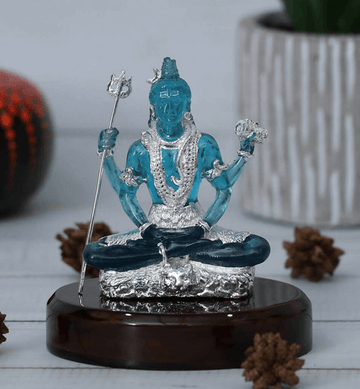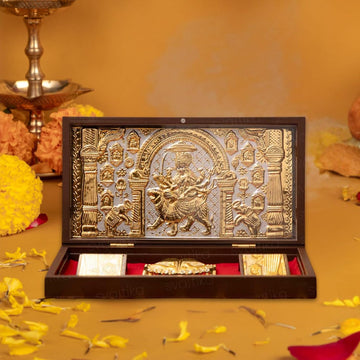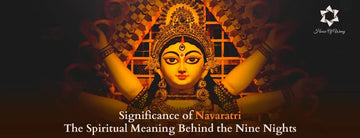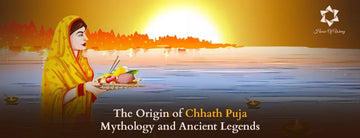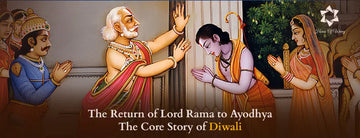The Spiritual Importance of Navaratri: Insights into the Nine Nights
The moment Navratri starts, every Indian home has a different, new story to tell. Some would recall the vibrant dhol beats while the Garba celebrations were at their peak, and some would still be able to get a scent of incense that was wafting out of that lamp lit by their moms just a little while before the Goddess Durga idols. The children are normally the epicenter of dressing up in bright clothes and just lounging around. Meanwhile, the elders are totally engrossed in prayer, fasts, and puja. This great mix of joy, tradition, and religion is what makes Navratri a unique one.
You cannot remark that Indian festivals are just rituals; they have origins in the old teachings. Now, what is religious about Navratri? The different observances? The teachings for these nine nights? Let us discover each one of the three.
Origin and Mythological Story Behind Navaratri
The Navratri festival meaning has a relation to Indian myths. The popular story could be traced back to the Devi Mahatmya, in which Goddess Durga was fighting against the demon king Mahishasura.
-
The fight was continuous for a total of nine nights and ten days, and thus was symbolic of the fight between good and bad. On the tenth day, Vijayadashami, Maa Durga defeated the demon and won.
-
Navaratri is linked to Ram's preparations for his battle against Ravana, during which he worshipped Goddess Durga for nine nights before Dussehra.
-
Stories show that deep struggles can be overcome with courage, faith, and will.
-
The Nine Nights are also symbolic of the nine steps to spiritual growth that conclude in the final triumph of the soul.
And you must have also noticed that every family, while celebrating festivals, is transferring these stories to continue the tradition to the ensuing generations.
Symbolism of Goddess Durga’s Eight Weapons

Why Navaratri is Celebrated: Spiritual and Cultural Importance
The mythical origins of Navratri's significance aren't the only ones that are crucial to it. Other than the myths, it's a calendrical festival that marks the change in the seasons.
- On the secular level, the festival is a harvest festival, and that's more evident in the North Indian region, where it is also called Sharad Navratri.
- On a spiritual level, it is a time for purging oneself, shedding, and re-establishing the rapport with the Shakti (female divine).
- On a general level, it is the symbolic form for inward struggle against pride, avarice, and wrath, and the dark side of human nature.
- On the cultural front, the festival is the culmination of community, music and dancing, and being together.
- As for religion, festivals are the occasion for religious celebrations of divine mothers, Navratri goddess worship, and gifts, among others.
All concur that Indian festivals are neither too devotional nor too celebratory but a perfect blend of both. Navratri is a perfect blend of both aspects.
The Nine Avatars of Goddess Durga Worshipped During Navaratri
Every day during Navaratri is dedicated to Navadurga (avatars of Maa Durga):
- Shailputri: The daughter of the Mountain, power personified.
- Brahmacharini: The living example of intense self-control.
- Chandraghanta: Signifies bravery and heroism.
- Kushmanda: Made the cosmos.
- Skandamata: The caring and loving motherly figure.
- Katyayani: Powerful form of Maa, slayer of demons.
- Kalaratri: Annihilator of darkness.
- Mahagauri: Purity and serenity.
- Siddhidatri: Provider of divine benedictions and completeness.
As our grandmothers chanted Navratri festival prayers, they also used to tell us about these forms, making us realize the divine virtues that we should adopt in our lives.
Significance of Each Day and Evening in Navaratri
The Navratri nine nights are something more than a calendrical event, but a journey for the soul.
- The first three nights are for tamas (darkness), removing negative energies.
- The following three nights are for rajas (action), focusing energy on doing something good.
- The last three nights are for sattva (purity), acquisition of wisdom, and calm.
You might also have experienced the transition within you while seeing the festival in reality.
Observed Customs and Rituals During Navratri
Navratri festival traditions vary from region to region, but some common Navratri festival rituals are:
- Kalash sthapana denoting Goddess Durga
- Daily aartis, bhajans, and Katha of Durga Saptashati
- Lighting the akhand jyot (unceasing diya lamp)
- Giving flowers and prasadam each day
- Maintaining fasts and breaking them with sattvik foods
As we are quite aware, these rituals gather the whole family in devotion and prayer.
The Symbolism of Navaratri as Good Over Evil
The victories of Maa Durga over Mahishasura and Lord Rama over Ravana are bigger than myths; they are our day-to-day battles. The Navratri significance is that it instills in us that:
- Truth shall prevail.
- Dark and light cannot exist together.
- Inner discipline leads to victory over external barriers.
You might have also observed the way Navratri instructs us to start afresh with hope at the culmination of each festival.
Importance of Fasting and Its Spiritual Benefit
Fasting carries Navratri importance in Hinduism. It is neither skipping the meal nor purification and control over oneself.
Benefits of Navratri fasting:
- Purifies the body with light, sattvik foods.
- Provides mental clarity and internal calm.
- Increases focus during prayers.
- Represents abandoning oneself to carnal lust.
As they say, “Upvas is not for the stomach, but for the soul.”
Navaratri Bhajans, Aartis, and Devotional Songs
Music and worship are inseparable components in Indian festivals. People come to the festival of Navratri to do puja with bhajans, mantras, and aartis.
- Performing aartis like Ya Devi Sarvabhuteshu brings divine vibrations into homes.
- Bhajans emit a favorable vibration that purifies the mind.
- Devotional songs bring people together in prayer.
You might have also engaged in night aartis where the sound of the bell and conch immersed the heart in tranquility.
Importance of Colors for the Nine Days
Each day of Navratri has a particular color that symbolizes different energies:
- Yellow – Happiness
- Green – Growth
- Grey – Balance
- Orange – Energy
- White – Purity
- Red – Courage
- Royal Blue – Strength
- Pink – Love
- Purple – Spirituality
As we are aware, the use of such colors not only makes us appear celebratory but also connects us to the day's energies.
Life Lessons from the Nine Days of Navaratri

Varied Regional Navaratri Celebrations in India
The Navratri celebration in India changes its flavor from state to state:
- In Gujarat, Garba and Dandiya are organized, commonly in societies (Sheri garba).
- In West Bengal, the Durga Puja festival is celebrated with beautifully decorated pandals.
- In Karnataka, the Mysore Dasara, a 10-day festival of Vijayadashmi, is celebrated with joy.
- Golu (doll display) in Tamil Nadu displays dolls that are typically thematic, narrating a legend from the Hindu scriptures
- In Himachal Pradesh, Kullu Dussehra is a week-long International Festival celebrated in the Dhalpur Maidan.
You are also likely to experience India's rich cultural diversity during a visit during Navratri.
Durga Puja in West Bengal and Its Connection with Navaratri
The biggest festival in Bengal is Durga Puja, which comes on Navaratri. Enormous Goddess Durga idols are crafted, pandals are elegantly constructed, and cultural programs are conducted. It represents the arrival of the Goddess and her children and the victory of good against the bad.
As we know, the rhythm of the dhak and the celebration in the sindoor khela are the culmination of the religious passion of Bengal.
Garba and Dandiya Raas: Dance Forms of Navaratri Celebrations in Gujarat
Navratri would be incomplete without Garba and Dandiya in Gujarat. They adorn colorful attire and dance around the lamp or Goddess Durga's idols.
- Garba symbolizes the beat of life.
- Dandiya represents the battle between Mahishasura and Durga.
You might also have swirled around in circles late at night and forgotten everything amidst the rhythm of devotion.
Mysore Dasara: Royal Navaratri Celebrations in Karnataka
Navratri is celebrated with great enthusiasm in Mysore as Mysore Dasara. The Mysore Palace is lit up, and a royal procession carrying the goddess Chamundeshwari's idol on a throne draped in gold is taken out.
As we know, the royal tradition of Karnataka provides a majestic feel to the festival.
Modern Festivals and Global Recognition for Navratri
Today, Navratri cultural traditions have also transcended geographical locations. People overseas celebrate Garba nights and Durga Puja, and prayer meetings. You see mass Navratri festivals in London, New Jersey, and Dubai.
You would have also seen how social media brings everyone together towards sharing in worldwide festivities.
Spiritual Lessons and Life Values to be Gained from Navratri
The Navratri festival is in the abiding teachings that Navratri imparts to us:
- Endurance amidst times of trouble.
- Patience and faith in hard days.
- The value of discipline and devotion.
- The value of belonging and oneness.
As our elders would also say, Navratri is something bigger than a festival; it is a guide for righteous and balanced living.
Conclusion
The Navratri spiritual significance is that Navratri teaches us that the feminine divine power is inside us. If we witness the rituals being celebrated on the Navratri festival occasion, if we sing Navratri festival songs, if we see Navratri fasting, we cleanse body and soul. Nine nights are no mere routine; they are a Navratri spiritual meaning.
As we are all aware, every Navratri comes to a close with recollections, devotion, and a fresh start. May this Navratri fill your life with light, strength, and blessings.
Continue reading, as in the next blog, we will reveal yet another insight of Sarasvati Avahan.

